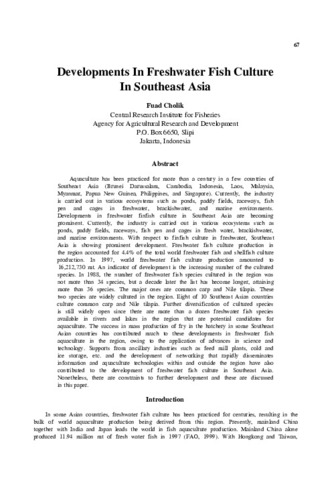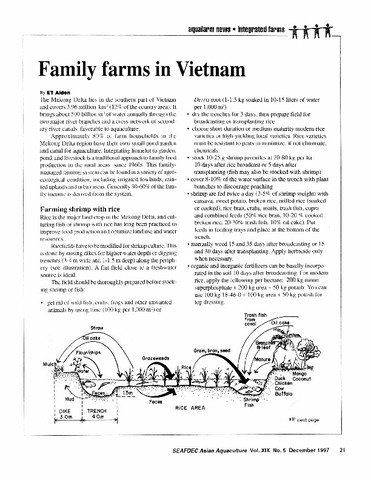Developments in freshwater fish culture in Southeast Asia
| dc.contributor.author | Cholik, Fuad | |
| dc.contributor.editor | Garcia, Luis Maria B. | |
| dc.date.accessioned | 2013-12-02T03:40:44Z | |
| dc.date.available | 2013-12-02T03:40:44Z | |
| dc.date.issued | 2001 | |
| dc.identifier.citation | Cholik, F. (2001). Developments in freshwater fish culture in Southeast Asia. In L. M. B. Garcia (Ed.), Responsible Aquaculture Development in Southeast Asia. Proceedings of the Seminar-Workshop on Aquaculture Development in Southeast Asia organized by the Aquaculture Department, Southeast Asian Fisheries Development Center, 12-14 October 1999, Iloilo City, Philippines (pp. 67-75). Tigbauan, Iloilo, Philippines: Aquaculture Department, Southeast Asian Fisheries Development Center. | en |
| dc.identifier.isbn | 9718511474 | |
| dc.identifier.uri | http://hdl.handle.net/10862/1804 | |
| dc.description.abstract | Aquaculture has been practiced for more than a century in a few countries of Southeast Asia (Brunei Darussalam, Cambodia, Indonesia, Laos, Malaysia, Myanmar, Papua New Guinea, Philippines, and Singapore). Currently, the industry is carried out in various ecosystems such as ponds, paddy fields, raceways, fish pen and cages in freshwater, brackishwater, and marine environments. Developments in freshwater finfish culture in Southeast Asia are becoming prominent. With respect to finfish culture in freshwater, Southeast Asia is showing prominent development. Freshwater fish culture production in the region accounted for 4.4% of the total world freshwater fish and shellfish culture production. In 1997, world freshwater fish culture production amounted to 16,212,730 mt. An indicator of development is the increasing number of the cultured species. In 1988, the number of freshwater fish species cultured in the region was not more than 34 species, but a decade later the list has become longer, attaining more than 36 species. The major ones are common carp and Nile tilapia. These two species are widely cultured in the region. Eight of 10 Southeast Asian countries culture common carp and Nile tilapia. Further diversification of cultured species is still widely open since there are more than a dozen freshwater fish species available in rivers and lakes in the region that are potential candidates for aquaculture. The success in mass production of fry in the hatchery in some Southeast Asian countries has contributed much to these developments in freshwater fish aquaculture in the region, owing to the application of advances in science and technology. Supports from ancillary industries such as feed mill plants, cold and ice storage, etc. and the development of networking that rapidly disseminates information and aquaculture technologies within and outside the region have also contributed to the development of freshwater fish culture in Southeast Asia. Nonetheless, there are constraints to further development and these are discussed in this paper. | en |
| dc.language.iso | en | en |
| dc.publisher | Aquaculture Department, Southeast Asian Fisheries Development Center | en |
| dc.subject | Cyprinus carpio | en |
| dc.subject | Oreochromis niloticus | en |
| dc.subject | South East Asia | en |
| dc.title | Developments in freshwater fish culture in Southeast Asia | en |
| dc.type | Conference paper | en |
| dc.citation.spage | 67 | |
| dc.citation.epage | 75 | |
| dc.citation.conferenceTitle | Responsible Aquaculture Development in Southeast Asia. Proceedings of the Seminar-Workshop on Aquaculture Development in Southeast Asia organized by the SEAFDEC Aquaculture Department, 12-14 October 1999, Iloilo City, Philippines | en |
| dc.subject.asfa | aquaculture development | en |
| dc.subject.asfa | aquaculture systems | en |
| dc.subject.asfa | fish culture | en |
| dc.subject.asfa | freshwater aquaculture | en |
| dc.subject.asfa | hatcheries | en |
Files in this item
This item appears in the following Collection(s)
-
ADSEA '99 [21]
Proceedings of the Seminar-Workshop on Aquaculture Development in Southeast Asia





